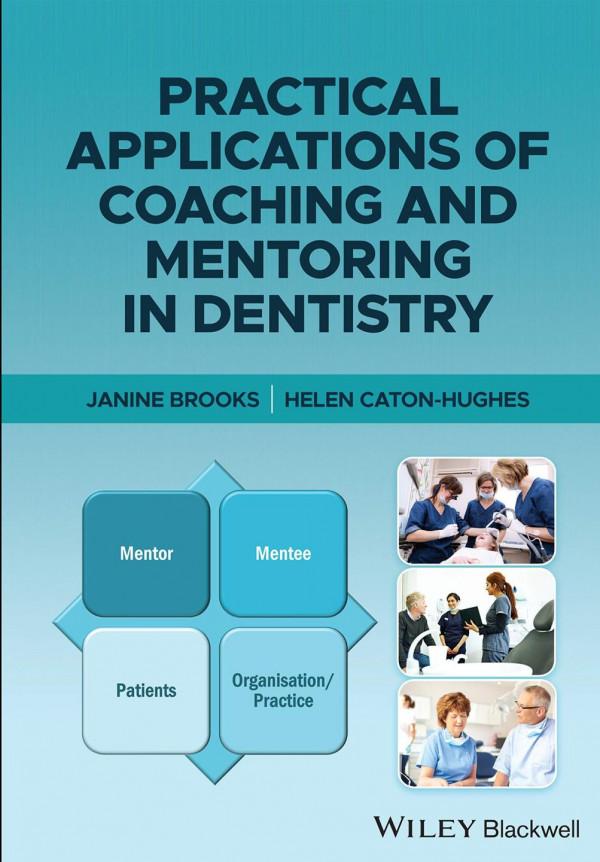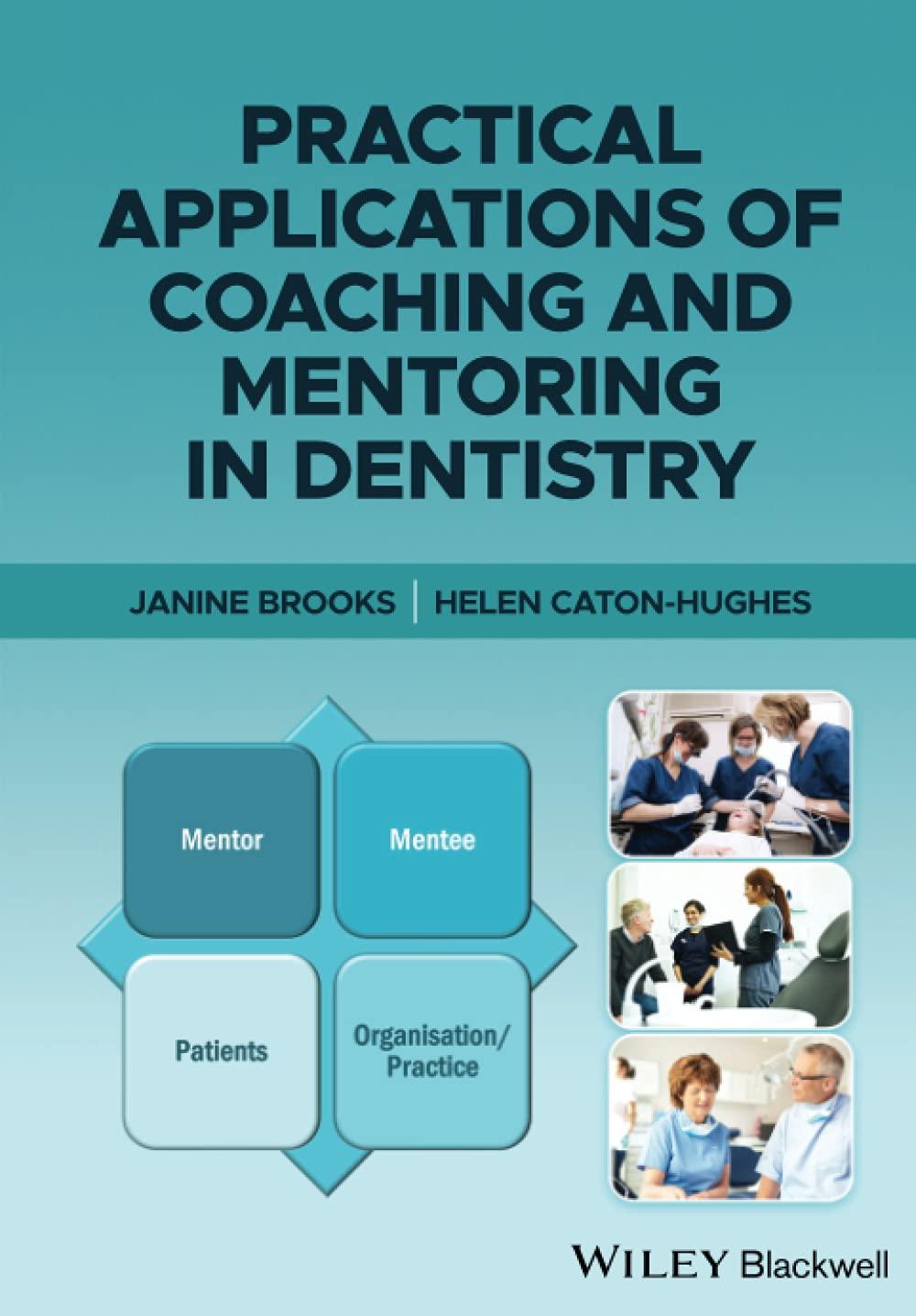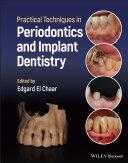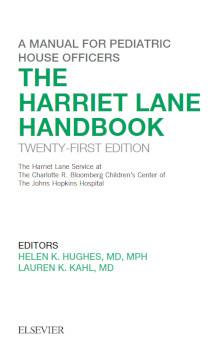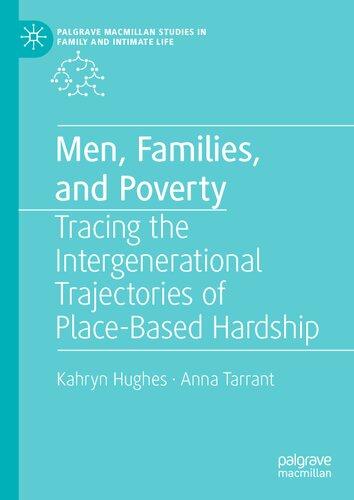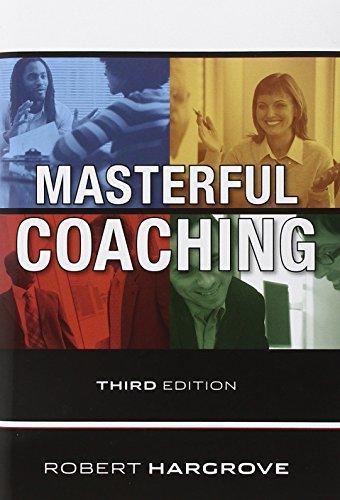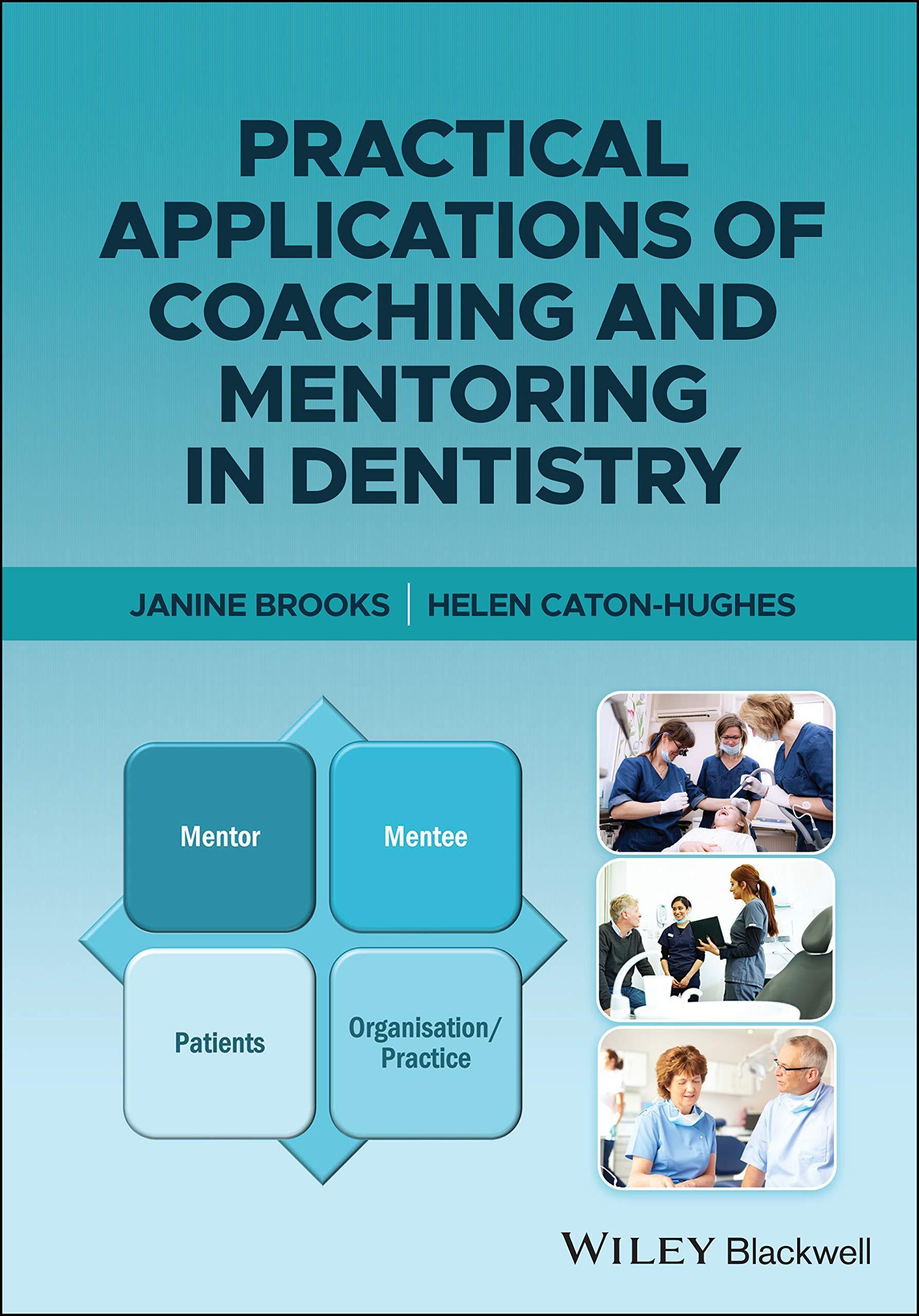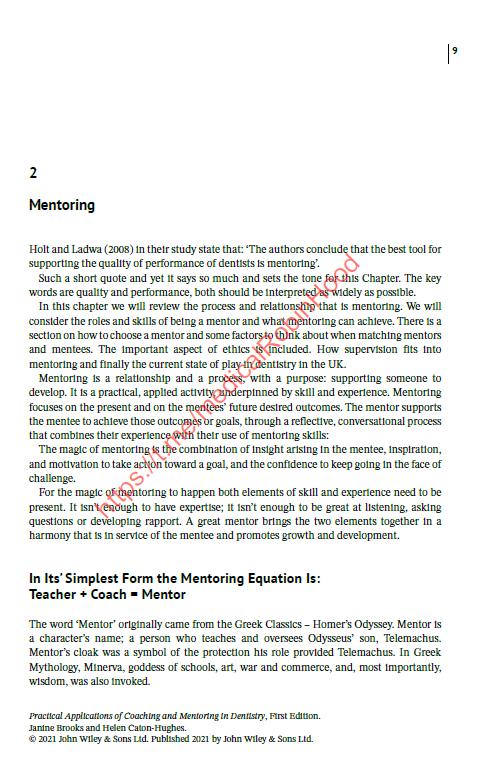Practical Applications of Coaching and Mentoring in Dentistry
Janine Brooks
Dental Coaching and Training Consultancy
Dental Coaching Academy
Dental Mentors, UK
Helen Caton-Hughes
The Forton Group Willoughby, UK
This edition first published 2021 © 2021 John Wiley & Sons Ltd
All rights reserved. No part of this publication may be reproduced, stored in a retrieval system, or transmitted, in any form or by any means, electronic, mechanical, photocopying, recording or otherwise, except as permitted by law. Advice on how to obtain permission to reuse material from this title is available at http://www.wiley.com/go/permissions.
The right of Janine Brooks MBE and Helen Caton-Hughes to be identified as the authors of this work has been asserted in accordance with law.
Registered Offices
John Wiley & Sons, Inc., 111 River Street, Hoboken, NJ 07030, USA
John Wiley & Sons Ltd, The Atrium, Southern Gate, Chichester, West Sussex, PO19 8SQ, UK
Editorial Office
9600 Garsington Road, Oxford, OX4 2DQ, UK
For details of our global editorial offices, customer services, and more information about Wiley products visit us at www.wiley.com.
Wiley also publishes its books in a variety of electronic formats and by print-on-demand. Some content that appears in standard print versions of this book may not be available in other formats.
Limit of Liability/Disclaimer of Warranty
The contents of this work are intended to further general scientific research, understanding, and discussion only and are not intended and should not be relied upon as recommending or promoting scientific method, diagnosis, or treatment by physicians for any particular patient. In view of ongoing research, equipment modifications, changes in governmental regulations, and the constant flow of information relating to the use of medicines, equipment, and devices, the reader is urged to review and evaluate the information provided in the package insert or instructions for each medicine, equipment, or device for, among other things, any changes in the instructions or indication of usage and for added warnings and precautions. While the publisher and authors have used their best efforts in preparing this work, they make no representations or warranties with respect to the accuracy or completeness of the contents of this work and specifically disclaim all warranties, including without limitation any implied warranties of merchantability or fitness for a particular purpose. No warranty may be created or extended by sales representatives, written sales materials or promotional statements for this work. The fact that an organization, website, or product is referred to in this work as a citation and/or potential source of further information does not mean that the publisher and authors endorse the information or services the organization, website, or product may provide or recommendations it may make. This work is sold with the understanding that the publisher is not engaged in rendering professional services. The advice and strategies contained herein may not be suitable for your situation. You should consult with a specialist where appropriate. Further, readers should be aware that websites listed in this work may have changed or disappeared between when this work was written and when it is read. Neither the publisher nor authors shall be liable for any loss of profit or any other commercial damages, including but not limited to special, incidental, consequential, or other damages.
Library of Congress
Cataloging-in-Publication Data
Names: Brooks, Janine, author. | Caton Hughes, Helen, author.
Title: Practical applications of coaching and mentoring in dentistry / Dr. Janine Brooks, Helen Caton-Hughes.
Description: First edition. | Hoboken, NJ : John Wiley & Sons, Inc., 2021. | Includes bibliographical references and index.
Identifiers: LCCN 2020045901 (print) | LCCN 2020045902 (ebook) | ISBN 9781119648260 (paperback) | ISBN 9781119648222 (adobe pdf) | ISBN 9781119648307 (epub)
Subjects: MESH: Mentoring | Dentists | United Kingdom
Classification: LCC RD37.2 (print) | LCC RD37.2 (ebook) | NLM WU 18 | DDC 617.0076–dc23
LC record available at https://lccn.loc.gov/2020045901
LC ebook record available at https://lccn.loc.gov/2020045902
Cover Design: Wiley
Cover Image: © (Top) Katja Kircher/Maskot/Getty Images;(Middle) Dean Mitchell/E+/Getty Images; (Down) Sturti/E+/Getty Images
Set in 9.5/12.5pt STIXTwoText by SPi Global, Pondicherry, India
Dedication
We would like to dedicate this book to all the hard working dental professionals who have successfully completed their post graduate qualifications in coaching and mentoring with Dental Coaching Academy. Their commitment to their profession, their own learning and development, and to coaching and mentoring has been an inspiration to us both, thank you.
Contents
About the Authors xii
List of Contributors xiv
Foreword xvi
Acknowledgements xviii
1 Introduction 1
History 2
Uses of Mentoring 3
Distinctions and Boundaries 4
What’s Inside This Book 6
How to Use This Book 6
References 7
2 Mentoring 9
In Its’ Simplest Form the Mentoring Equation Is: Teacher + Coach = Mentor 9
Who Is a Mentor? 11
Why Be a Mentor? 11
Reverse Mentoring 11
Inter-professional Group Mentoring 12
The Roles of an Effective Mentor 12
What Can Mentoring Achieve? 14
Choosing a Mentor 15
The Power Relationship in Mentoring 15
Compatibility and Rapport 16
Diversity 16
Degree of Interest 16
Logistics 16
Personality 17
Roles and Responsibilities 17
Matching Mentor and Mentee 17
Ethics 18
Supervision 20
The Current State of Play 21
Conclusion 22
References 22
3
Coaching 23
What Is Coaching? 23
Purpose of Coaching 25
Example 25
Some Coaching Examples 26
Distinctions Between ‘Coaching’ and ‘Mentoring’ 27
Ideas that Underpin Coaching 28
Resources and Resourcefulness 28
Egan’s “Skilled Helper” Model 29
The Traditional Role of a Skilled Helper 30
How Does Coaching ‘ Work’? 31
Conclusion 32
References 32
4
The Forton Model 35
Skills and Competencies of Coaching 35
Definition of a ‘Skill’ 36
Definition of Competency 36
The Role of the Coach 37
Tools for Mentoring and Coaching 37
The Coaching ‘Journey’ 38
Purpose 38
Reality 38
Plan 39
Action 39
Review 39
The Forton Model 39
Coaching Principles 40
Partnership 40
Principle Two: Trust 43
The Coach Trusting Themselves 44
Principle Three: Presence 44
Principle Four: Possibility 45
Principle Five: Accept, Blend, and Create (A, B, and C) 46
The Skills of Coaching 46
Receptive Listening 47
Asking Great Questions 48
The Skills of Reflecting 49
The Skills of Supporting 50
The Steps of the Coaching Conversation 51
Purpose: Setting and Meeting Objectives 51
Scoping Questions: The Coaching Conversation Purpose 51
Current Reality 52
Tapping into the Coachees’ Resourcefulness 53
New Insights – The Plan Step 54
Tactics 55
Overcome Barriers 55
Review Steps 55
The Review Step: From One Conversation to Another 56
Reflective Learning in Coaching 56
Receiving Feedback 57
The ‘Field’, or the World of the Coachee 58
References 58
5 Practical Case Studies 61
Background to the Case Studies 61
Improving UK Dental Service Quality 61
Underpinning Concepts 62
The Role of Coaching and Mentoring in Supporting Dental Service Quality 63
The Case Study Projects 64
Case Study Categories 64
Category One Case Studies: Dentists in Difficulty Including PASS 64
Local Dental Committee (LDC) 64
Practitioner Advice and Support Scheme (PASS) 64
PASS Aims and Objectives 65
PASS Processes 65
Case Study One 65
Thames Valley PASS Contributor: Dr Barkat Ahmed BDS 65
Programme Success Indicators 65
Referrals to the Mentoring Scheme 67
Mentoring Group Evaluation 69
Case Study Two 70
The Dorset PASS Contributor: Mrs. Sarah Jackson BDS 70
Case Study Three 72
Dentists in Difficulty Including PASS Contributor: Dr. Sumair Khan BDS 72
Case Study Four 74
Designing and Implementing a Mentoring Scheme in Birmingham Contributor:
Dr. Ahmad El-Toudmeri BDS 74
Category Two Case Studies Evaluation 77
Case Study Five 78
An Evaluation Methodology: A Piece of Reflective Writing for PAG Contributor:
Dr. Claudia Peace BDS 78
Category 3 Case Studies: Early Years in a Dentists’ Career 80
Case Study Six: Educational Supervisors and Foundation Dentists 80
Contributor: Dr Frederick Fernando BDS 80
Evaluation of the Educational Supervisor as a Mentor 82
Issues Uncovered During the Process 82
Poor Performance 83
Communication 83
Poor Self-awareness 83
Case Study Seven: Assessing How Coaching and Mentoring Can Impact Dental
Students in an Outreach
Setting Contributor: Dr. Stephen Denny BDS 84
Southend Outreach Academic Clinic 84
Creating the Mentoring Environment – Spheres of Influence 85
Case Study Eight: Year 1 Post Foundation Dentists Contributor: Dr. Keith George BDS 88
Case Study Nine: Smile Restorative Mentoring Programme Contributor: Dr Jin Vaghela BDS 89
Why Mentoring? 90
The Mentors 91
Category Four Case Studies: Risk Management and Quality Assurance (QA) 91
Case Study Ten: Denplan Risk Management/QA (Contributors: Dr Ewa Rozwadowska BDS and Dr. Catherine Rutland BDS) 92
Risks Experienced by Dentists 92
Category Five Case Studies Tools/Models 95
Case Study Eleven: Using Coaching Cards – Tools or Props? Contributor:
Ms. Jane Davies-Slowik MBE BDS 95
Domain 1: The Principles of Coaching 97
Domain 2: Coaching Skills 97
Domain 3: The Steps 98
Domain 4: The Field, i.e. Resources 98
Emotional Intelligence 99
Coaching for Values 99
Practical Ways of Using Coaching Cards for Team Coaching 99
Practical Ways of Using Coaching Cards for Individual Coaching 100
Self-development 101
Conclusion 101
Case Study Twelve: Contributor: Mrs. Shilpa Chitnis BDS 102
P – PERSPECTIVE 102
E – EMPATHY 102
A – AWARENESS 103
R – RAPPORT 103
L – LISTENING 104
S – SUPPORT 105
References 106
6 Discussion 109
Beyond One-to-One: Coaching and Mentoring Groups and Teams 110
Group Coaching and Mentoring 110
Team Coaching and Mentoring: Shared Goals and Direction 111
Coaching in Virtual Environments 111
Coaching in Organisations: Organisational Dynamics, Does Size Matter? 112
Coaching and Mentoring Boundaries 112
How and When to Use Coaching and Mentoring 113
Barriers to Introducing Coaching and Mentoring 114
Attitudinal Barriers 114
Structural Barriers 115
Typical Benefits of Coaching and Mentoring 115
Impact of Coaching and Mentoring 116
Prevention 116
Neutralising 116
Remediation 116
Performance Conversation 116
Development Conversation 117
Themes from the Case Studies 117
Personal Performance 117
Health and Well-Being 118
Key Take Away Messages 120
Communication 120
Key Take Away Messages 121
Mentoring and Coaching as Regular and Every Day 122
Key Take Away Message 122
Supportive Culture for Coaching and Mentoring 122
Key Take Away Messages 122
Share and Enjoy 123
Key Take Away Messages 123
Integrating Mentoring into Structures and Systems 123
The Whole Professional Career 123
Key Take Away Messages 124
Organisational Culture 124
Myth Busting 125
‘Deskilling’ 125
Anyone Can Mentor 126
Age – ‘reverse mentoring’ 126
Inter-professional Mentoring 127
Reflection Is Not Measurable; Therefore, Not Worthwhile 127
Failure Is Failure – Or Is It an Opportunity to Learn and Improve? 128
No Time to Mentor 128
A Note for Covid-19 129
Conclusion 129
References 130
Glossary of Terms – Organisations and Other Descriptors 133
Further Reading 139
Index 140
About the Authors
Janine Brooks MBE, DMed Eth, MSc, FFGDP(UK), MCDH, DDPH(RCS), BDS, FAcadMEd, is CEO of Dentalia Coaching and Training Consultancy; Director of the Dental Coaching Academy; Co-founder of Dental Mentors UK; a private Coach and Mentor (Remediation, Career and Personal Development), Educational Associate and Registration Assessment Panelist for the General Dental Council; Trustee of the Dentists’ Health Support Trust; Coach for the Professional Support Unit, Thames Valley; Expert Witness; Lead Clinical Tutor at the University of Bristol (BUOLD programme) and Honorary Fellow, Society of British Dental Nurses.
Janine enjoys a portfolio career working across a number of roles and organisations. Themes running through her work include education, mentoring and coaching. She launched my own coaching and training consultancy, Dentalia, in July 2011, providing coaching and mentoring to dental professionals and a broad range of education and training topics. She writes extensively and has published several books, plus a number of articles and papers over the years.
Helen and Janine along with their partner Bob launched a Post Graduate Certificate and a Post Graduate Award in Leadership Coaching and Mentoring in 2016. Over 60 dental professionals have successfully completed their qualifications to date.
Janine qualified from University of Birmingham dental school in 1983 and spent 19 years working as a Community Dentist in Herefordshire and Warwickshire before taking on national roles. Her main interests lie in bio ethics, professionalism, leadership in dentistry and mentoring.
Helen Caton-Hughes, MA, DipM, PCC, is an author, coach and founder of the Forton Group of companies. She combines her interest in health and wellbeing with leadership development and coaching. Her books include ‘The Fertility Plan’ and ‘No Cape Required: empowering abundant leadership’ (co-written with Bob Hughes).
Independent quality standards and a clear evidence base matter to her and Helen is an assessor for the International Coach Federation and a coach supervisor and mentor.
As a leadership, career and business coach, Helen works across the spectrum of health management, business development and marketing, with leaders from the private, public and humanitarian sectors and with their teams. Her clients include the UN, financial services and the UK National Health Service and leaders in fast growing technology companies, humanitarian organisations and logistics.
As a pioneer in digital business, Helen has built her own organisation based on flexible working patterns, digital technologies and self-paced remote learning. Equally at home in the classroom, Helen enjoys encouraging her students to discover their strengths, build their confidence and grow their careers as a result.
Helen’s research includes youth volunteering, care home quality and the impacts of coaching on organisations. It’s important to her that research findings get turned into actionable steps and, as a result, she designs training courses, including Post-Graduate programmes in leadership, coaching and mentoring, team-coaching and training in coachmentoring and supervision. Helen also led the team that achieved the first International Coach Federation accredited programme to focus on leadership coaching.
Strongly committed to diversity, Helen works internationally, and inspired the development of abundant leadership, building on peoples’ diverse strengths and talents, as well as their culture and values.
List of Contributors
Dr. Barkat Ahmed
BDS, CerMedEd, PGCert Dent Imp, Diploma (Coaching and Mentoring) Oxford, UK
Mrs. Shilpa Chitnis
BDS, PGCert Leadership Coaching and Mentoring
GDP Practice Principal Coach Mentor Andover, UK
Ms. Jane Davies-Slowik MBE
BDS‐ BDS MCDH DDPHRCS, PGCert Leadership Coaching and Mentoring Birmingham, UK
Dr. Stephen Denny
BDS, LDSRCS, PG Cert Dental Education, PGCert Leadership Coaching and Mentoring
Educational Supervisor; Honorary Tutor, Southend Outreac; Clinical Educator University of Essex Southend, UK
Dr. Ahmad El-Toudmeri
Dental Surgeon, BDS Sutton Coldfield, West Midlands, UK
Dr. Frederick Fernando
Dental Surgeon BDS PG Cert CMI Saffron Walden, Essex, UK
Dr. Keith George
B.D.S D.P.DS, PGCert Leadership Coaching and Mentoring Burford, UK
Mrs. Sarah Jackson
BDS, PGCert Leadership Coaching and Mentoring
Dental Surgeon Poole, Dorset, UK
Mr. Sumair Khan
BDS (Lon) MFDS RCPS (Glas) MSc (Implant Dent) Diploma (Rest Dent)
PGCert (Medical & Dent Ed) PGCert (Leadership Coaching & Mentoring)
Training Programme Director ‐ Oxford
Dental Foundation Training Scheme
Health Education England Thames Valley & Wessex
Course Director ‐ Postgraduate Diploma in Implant Dentistry
Smile Dental Academy Oxfordshire, UK
Dr. Claudia Peace
BDS, PGCert Leadership Coaching and Mentoring
Dental Surgeon Winchester, UK
Dr. Ewa Rozwadowska
BDS, PGCert Leadership Coaching and Mentoring
Dental Surgeon Cheltenham
UK
Dr. Catherine Rutland
BDS MA, BChD, IRMCert, CMI, BDS, PGCert Leadership Coaching and Mentoring
Clinical Director, Simplyhealth and Denplan Winchester, UK
List of Contributors
Dr. Jin J. Vaghela
BDS (Lond) MFDS RCSEd (Edin) (London)
MJDF RCS (Eng) PG Cert (Dental Education) FHEA PG Cert Leadership, Mentoring & Coaching MSc Restorative Dental Practice (Eastman)
DFT Educational Supervisor Health Education East of England; Visiting Lecturer Eastman Dental Institute; Visiting Lecturer Royal College of Surgeons; Clinical Director Smile Clinic Group; Clinical Director Smile Dental Academy, London, UK
Foreword
When asked by the authors whether I would write a foreword to this book I felt hugely privileged. Having been trained in mentoring and coaching by them several years ago, their knowledge and passion for mentoring and coaching in dentistry should be written down to aid those of us who are always still learning.
The power of mentoring and coaching is still not fully used in dentistry. As I progress further though my career I see more and more the impact of what it can achieve. Whether in a formal setting, or supportive conversations within teams, it can really alter how individuals and teams progress and perform, ultimately leading to improved patient care.
This book and the methods it suggests are grounded in solid theory, and techniques and methods well tested and proven. The case studies within it show how mentoring and coaching can work in the real and often challenging world of dentistry.
It can be so easy to focus on clinical improvement within our development, yet there are so many other areas of our professional lives in which we can improve and work on. This can often get missed, yet a good mentor or coach will draw this out, ultimately leading to a more rounded and balanced career and, with that, a better work life balance and sense of wellbeing.
It is also important to recognise the joy and pleasure of being a mentor or coach, and watching people develop. Personally, that is one of the main reasons I worked for my qualification. I have been rewarded time and time again for the work required to achieve it, by seeing how you can support those who wish to engage.
Our careers can often take unexpected twists and turns, due to so many different factors, mine certainly has. Yet if you have someone to turn to who will mentor or coach you, depending on your need at the time, you find opportunities in the directions you can take and skills you may not have even known you had.
Enjoy this book and what it teaches you, and remember it is just the start of a bigger, and hugely rewarding journey.
Dr. Catherine Rutland MA, BChD, IRMCert, CMI, BDS, PGCert Leadership Coaching and Mentoring
August 2020
Acknowledgements
We would like to acknowledge the kind participation and contributions of colleagues who generously shared the projects they have developed. Their projects have been included to help the profession to benefit from their experiences of introducing and using mentoring within dentistry.
Thank you to all our Case Study contributors: Dr. Barkat Ahmed, Dr. Jane Davies-Slowik MBE, Dr. Stephen Denny, Dr. Frederick Fernando, Dr. Keith George, Dr. Sarah Jackson, Dr. Sumair Khan, Dr. Claudia Peace, Dr. Ewa Rozwadowska, Dr. Catherine Rutland, Dr. Ahmad El-Toudmeri, Dr. Jin Vaghela, Dr. Shilpa Chitnis.
We would also like to thank our husbands, John Brooks and Bob Hughes for their unfailing support and encouragement, not to mention proof reading expertise.
Introduction
This book principally concerns itself with practical applications of mentoring within the profession of dentistry in the United Kingdom (UK). Whilst the book is written to showcase case studies within dentistry in the UK it is important to acknowledge that the skills of both dental professionals and mentors are not dissimilar throughout the world. If you are working outside the UK whether in dentistry or different field you will find much that you can take away from the book and the case studies. It is also important to acknowledge that whilst the case studies relate to dentists, their application is equally valid for all dental professionals.
The inspiration for the book came from students who have completed our post graduate certificate and award qualifications in mentoring and coaching. They are hard-working dental professionals with a passion for both dentistry and mentoring and we are indebted to their contributions. Future students will be directed to this publication as a course book, however it is not limited to being a course text.
We provide a number of case studies for projects which showcase how mentoring is being utilised in positive ways to enhance individuals and the services those individuals provide. The aim is to demonstrate how mentoring programmes can be implemented and the benefits they can bring. We invite you to submit your own case study examples to our website at www.dentalcoachingacademy.co.uk.
Whilst mentoring is a practical intervention it is underpinned by sound theory and the acquisition of mentoring skills. We have included chapters that describe mentoring and coaching as the two interventions share a number of skill areas, yet are quite different in purpose and application. We have also included a chapter on mentoring and coaching tools and models with particular attention to a model that we have successfully used in our training programmes. The discussion chapter will review topics that the case studies have introduced and other aspects that we hope will provoke further thought.
Please note: for readers outside the UK or those who are not dental professionals, organisations within the UK that relate to dentistry may read like alphabet soup. We refer you to the glossary for a brief explanation of the organisations and terminology used. Please also note that, unless we make specific distinctions, we use terms like ‘coach’ and ‘mentor’ interchangeably, as we hold no attachment to the terms in their general usage. If you want to ‘coach’ someone, that’s great; if you prefer to ‘mentor’ them, that’s fine too. Both are
Practical Applications of Coaching and Mentoring in Dentistry, First Edition.
Janine Brooks and Helen Caton-Hughes.
© 2021 John Wiley & Sons Ltd. Published 2021 by John Wiley & Sons Ltd.
possible as dental professionals supporting others’ growth and development in general terms; or when we are acting as managers and leaders and drawing on coaching and mentoring skills generally. Where we make distinctions is when these skills are applied in professional settings and a precise tool, or approach is required by the context.
Mentoring is increasingly being seen by organisations generally, and the dental profession in particular, as a way of helping and supporting the development of people (employees, staff, contractors, patients) to achieve their goals. The word mentor has come to mean trusted adviser, friend, teacher, and wise person. The term ‘coach’ has been more commonly associated with someone supporting personal and professional performance, goal achievement, and drive. We aim to broaden both these terms to encompass enhanced selfawareness, development, personalised learning, and excellence in practise.
In dentistry we are still at the beginning of appreciating the potential and benefits of mentoring. In our experience more and more dental professionals are undertaking training to become mentors, such that these skills are applied more intentionally and more professionally. As will become evident as you read through the book, great mentors combine skill, expertise, and experience with the skills of mentoring in the service of another individual, the mentee. The practical skills, expertise, and experience that others wish to learn and emulate will not be covered by the book, they are taken as present. What the book does cover are the skills of translating that expertise and experience into a worthwhile, productive conversation, and relationship that promotes growth and development of another individual, the mentee.
History
Mentoring has slowly been gaining a position within dentistry since the Millennium with more and more dental professionals becoming familiar with the term and the concept of mentoring. It is also good to see this recognition from the statutory regulator for dental professionals.
Activities such as coaching and mentoring, where individuals are supported by other members of the dental profession, also have an important role to play here, and are valuable ways of enhancing the skills and approach of all involved.
Shifting the Balance: a better, fairer system of dental regulation (GDC 2017).
Vernon Holt did much to champion mentoring within the dental profession and his series of articles written between 2008 and 2010 are referenced frequently through the literature. Holt produced his thesis in 2013 and it contains a rich mine for those wishing to know more about mentoring in dentistry.
I suggest that a culture proactively supportive of practitioners at all stages of their careers using routine mentoring could do more than any amount of audit of techniques, protocols or choosing of ‘the latest’ materials, to enhance the quality of care delivered. Furthermore, because the dentist has a leadership role in the practising
environment, the quality of performance of the dentist in the team can have a profound effect on the morale and culture of the team of which he or she is a part. This in turn will influence the quality of patient care indirectly as well as the direct effect through his/her own clinical performance (Holt 2013, p. 24).
It is from the 1980s that we start to see the emergence of a body of literature about mentoring in American business management (Colley 2002). Influential articles, particularly Roche’s report, Much Ado about Mentoring (1979), claimed to have discovered mentoring as an informal but important part of a businessman’s career. Mentoring in Britain then began to be seen as an American import, which had to be adapted to British culture. Clutterbuck was instrumental in the 1980s in bringing the idea of mentoring to Britain from the United States. He is regarded as the ‘grandfather’ of mentoring in the UK.
There is also anecdotal evidence to suggest that Continuing Professional Development (CPD) which involves interaction with professional colleagues has significant benefits when compared with other non-interactive activities, e.g. reading, or online CPD. While there is room for a mix of CPD activity, we all need to consider how to ensure that the benefits of interactive CPD are recognized and realised. Activities such as coaching and mentoring, where individuals are supported by other members of the dental profession, also have an important role to play here, and are valuable ways of enhancing the skills and approach of all involved (GDC Moving upstream 2020, p. 32).
Uses of Mentoring
Considering the widely varying circumstances and professional isolation of general dental practice, the most adaptable tool for supporting the quality of performance of dentists is likely to be mentoring (Holt 2013, p. 34).
Experience since Holt wrote the above sentence has shown that the potential for mentoring goes beyond quality performance. The case study examples in Chapter 5 highlight the following areas of benefit:
● Career development
● Quality assurance
● Improving communication
● Deepening insight and self-awareness
● Excellence
● Remediation of poor performance.
These are also explored further in the discussion chapter. It’s not only the dental practices that benefit from mentoring, the 2004 National Health Service (NHS) national staff survey (Healthcare Commission 2005) noted that 17% of staff identified that they had received training and development from a mentor during the previous 12 months.
The Department of Health, NHS knowledge and skills framework and development review (2004, p. 8) highlighted two key messages that relate to mentoring:
● Mentoring is key to the future of the NHS.
● A national framework for mentoring is to be created.
Viney and Paice (2010, p. 38) reporting on the London Deanery ‘First Five Hundred’ mentees concluded: ‘The first five hundred mentees have confirmed our conviction that this service is needed and appreciated by a significate number of doctors and dentists’ Increasingly, as clinical leadership grows, the use of mentoring and coaching to support leadership development is also growing. Many leadership programmes for health professionals now including a blend of training, development, mentoring, and coaching, as well as training for clinical leaders in mentoring and coaching skills.
Distinctions and Boundaries
As Clutterbuck outlined in 2001, there is considerable confusion over what mentoring is and what it is not. It can often be confused with other methods of professional support.
Here we make clear distinctions between counselling, advice-giving, coaching, and other ‘talking’ interventions. The distinctions focus on three key elements of mentoring:
● The type of support and level of advice that a Mentor gives a Mentee.
● The way in which support and advice is offered.
● The role(s) which the Mentee expects the Mentor to play.
For example:
● Counsellors tend to work with clinical issues and go back to the past before going forward. It’s often a one-way relationship, with therapeutic intention.
● Mentors and coaches work with successful, healthy people and start in the present, then go to the future. In both cases, a two-way relationship is established – for example, mentors and coaches will share personal information and experience.
● Coaching encourages a partnership approach in the conversation, whereas a mentor, by dint of experience, knowledge, and connections, has greater perceived status and power than the mentee.
The divide between mentoring and coaching is less clear cut. Both work by encouraging self-discovery and self-resolution. A mentor is more likely to be an expert in the field and has been chosen because the mentee will look for advice and guidance from the mentor. A coach does not need to have any subject knowledge in order to produce results.
The range of skills or approaches used in mentoring may include training, advice, and career counselling. Understanding the distinctions between counselling, advice-giving, coaching, and other ‘talking’ interventions is important.
Advice-giving may include technical advice or business advice, and it’s vital that mentors only give advice within the boundaries of their professional competencies and experience.
By comparison, a coach may offer examples from their own experience, but expect the coachee to use that example as a story or metaphor, for them to make sense of within their own context rather than as advice-giving.
This is not to set up either mentoring, coaching, or indeed any talking approach as ‘better’ or otherwise. Each has their role and benefits. The authors have been retained professionally as consultants, coaches, and mentors; their clients may, or may not, have been working separately with therapists or advisers. These are not competing modalities, rather they can be complementary. The mentee is an autonomous adult, capable of making their own decisions about what they need, and who they need to work with, in order to be personally and professionally successful.
Coaching and mentoring is also a style of leadership (Goleman et al. 2001) which can be summarised as a style of leadership that takes into account, and brings together what a person wants with the organisation’s goals.
Table 1.1 A comparison of various interventions.
Therapy Mentoring Consulting Coaching
Focus of work Deals mostly with a person’s past and trauma, and seeks healing. Deals mostly with succession training, and seeks to help the one being mentored to do as the mentor does Deals mostly with problems and seeks to provide information (expertise, strategy, structures, methodologies) to solve the problems
Relationship Doctorpatient relationship (therapist has the answers)
Emotions Assumes emotions are a symptom of something wrong
Process The therapist diagnoses, and then provides professional expertise and guidelines to give the client a path to healing.
Older/wiseryounger/less experienced relationship (mentor has the answers)
Expert-person with problem relationship (consultant has the answers)
Is limited to emotional response of the mentoring parameters (succession, etc.) Does not normally address or deal with emotions (informational only)
The mentor allows student to observe mentor’s behaviour, expertise: answers questions; provides guidance and wisdom for the stated purpose of the mentoring.
The consultant stands back, evaluates a situation, and then tells client the problems and how to fix it.
Deals mostly with a client’s present, and seeks to guide the client into a more desirable future.
Co-creative equal partnership (coach helps client discover own answers)
Assumes emotions are natural, and normalises them
The coach stands with the client, and helps the client identify the challenges. Then they work together to turn challenges into victories. The client is held accountable to reach his or her desired goals.
Coach-like leaders and managers have conversations with their staff that go beyond short-term concerns, individual performance or team goals, and instead explore the person’s life, including their dreams, life goals, and career hopes. This coach-like leaderships style has been identified as a key factor of better employee engagement (Engage for Success 2009), notably the ‘Four Enablers’ of engagement.
What’s Inside This Book
Having outlined some key differences between interventions we can move onto think about how the book is structured.
Chapter 2 provides an outline of the mechanics of mentoring. This is an opportunity to consider the who and why of mentoring. The characteristics of mentoring and being a mentor are reviewed. We explore what mentoring can achieve and the different types of mentoring. There is a section on criteria that can help when choosing a mentor. The ethics of mentoring are also an important consideration in this chapter.
Chapter 3 reviews coaching: looking at what we mean by coaching, including definitions from the major coaching bodies. It also looks at some of the underpinning ideas or theories that inform coaching and which distinguishes this type of conversation from others, including differences between ‘mentoring’ and ‘coaching’. This theory is applied through the practical skills covered in the following chapter.
Chapter 4 considers models used within mentoring and coaching with particular emphasis on the Forton model which is used extensively in our qualifications.
Chapter 5 is the key focus of the book, the case studies. Here we include 12 case studies generously provided by each of our contributors. The case studies are real examples of how to use mentoring practically within dentistry in the UK. The studies have been grouped into five categories which include: dentists in difficulty; evaluation; early years – undergraduates, foundation dentists, and post foundation; general practice; and organisational culture and models/tools. They showcase the diversity of using mentoring alongside mentoring tools and related techniques.
Chapter 6 covers discussion and conclusions. In this final chapter we review some of the lessons learned from the case studies and important themes that thread through. Communication is an aspect that can be found across the case studies and the categories of study. We look at some myths around mentoring and attempt to bust those myths. Looking beyond 1 : 1 mentoring is discussed as we consider team mentoring. Boundaries and barriers to mentoring also figure in the discussion and we conclude with a call for more case study contributions, to build on the body of knowledge, and with pointers for the way forward for coaching and mentoring in dentistry.
How to Use This Book
We invite you to apply choice in how you use this book! Some people like to read cover to cover, and the format also encourages dipping into a chapter at a time, depending on your preferred approach.
This is a ‘text book’, in as much as any book about coaching or mentoring can be; specifically for the post-graduate qualification programmes we teach. We also hope that dental professionals around the world will use this book as a starting point for developing their own skills and setting out on their own coaching and mentoring journey.
Inspiration is a personal experience, and yet we aspire to inspire. We hope this book will inspire you to find a coach or mentor, or to try out the coaching approach in your role as leader or manager or indeed to train to become a mentor or coach.
We also hope that you’ll use this book to find out more about coaching and mentoring; we offer references at the end of each chapter and a ‘Further Reading’ list at the end of the book. We also invite you to get in touch with the authors, through the websites listed in the ‘Further Reading’ section.
References
Clutterbuck, D. (2001). Everyone Needs a Mentor: Fostering Talent at Work. Chartered Institute of Personnel and Development.
Colley, H. (2002). A ‘rough guide’ to the history of mentoring from a Marxist feminist perspective. Journal of Education for Teaching 28 (3): 247–263. Department of Health (2004). The NHS knowledge and skills framework and the development review process.
Engage for Success (2009) https://engageforsuccess.org/the-four-enablers.
Gallwey, T., (1974) The Inner Game of Tennis. Joanathan Cape.
General Dental Council (2017). Shifting the Balance, A better, fairer system of dental regulation.
General Dental Council (2020). Moving upstream p.32.
Goleman, D. (2000). An EI-based theory of performance. In: The Emotionally Intelligent Workplace How to Select for, Measure, and Improve Emotional Intelligence in Individuals, Groups, and Organizations (eds. D. Goleman and C. Cherniss). San Francisco, CA: Jossey-Bass.
Healthcare Commission (2005). NHS national staff survey 2004 – summary of key findings. Holt, R. (2013). Thesis, developing an holistic and person centred approach to professional practice and development using mentoring (with special reference to dentistry). Originally submitted for examination May 2013.
Holt, R., Ladwa, R., (2008). Mentoring. A quality assurance tool for dentists. Part 1: the need for mentoring in dental practice. Primary Dental Care. Oct:15(4):141–6.
Roche, G.R. (1979) Much Ado about mentors. Harvard Business Review [Online]. Available at https://hbr.org/1979/01/much-ado-about-mentors (Accessed 09 June 2020).
Viney, R. and Paice, E, (2010). The First Five Hundred. A Report on London Deanery’s Coaching and Mentoring Service 2008–2010. The London Deanery. Whitmore (1992). Coaching for Performance: Growing People, Performance and Purpose. Nicholas Brealey.
Combining these two powerful symbols creates a ‘whole person’: guided and taught externally, with inner wisdom and learning. Thus, mentor has come to mean trusted adviser, friend, teacher, and wise person.
The process of mentoring is defined in many ways:
Off-line help by one person to another in making significant transitions in knowledge, work, or thinking (Clutterbuck and Megginson 1995).
Mentoring is a developmental relationship where one person, typically older, or more experienced, or with more expert technical knowledge, shares their knowledge, skills, information, and perspective to support the personal and professional growth of someone else. In some cases, the mentor may also share their contacts or networks (Forton Group 2002).
The process whereby an experienced, highly regarded, empathic person (the mentor), guides another individual (the mentee) in the development and re-examination of their own ideas, learning, and personal and professional devel
opment. The mentor who often, but not necessarily, works in the same organisation or field as the mentee, achieves this by listening and talking in confidence to the mentee (The Standing Conference on Postgraduate Medical and Dental Education SCOPME 1998).
-
Skill, experience or expertise that is valuable to the mentee
Using mentoring skills effectively and in the service of the mentee
The magic of mentoring
Figure 2.1 Experience + skill = mentoring magic.
Mentoring can be provided using a variety of formats. Face to face is perhaps the most frequently used, or there is distance/virtual mentoring using telephone or internet platforms where the mentor and mentee are in different locations, but it is still a one to one relationship.
Group mentoring is where a single mentor works with a group of mentees, for example within a dental practice setting, or via audio or visual conference facilities.
Who Is a Mentor?
The mentor is generally (although not always) a senior member of the profession who has a combination of experience, position, authority, and status. Regardless of seniority, mentors possess some experience, knowledge, and skills that are greater than the mentee.
Experience, knowledge, and skill acquisition is not age dependent and, in today’s intergenerational workforce, less about older people mentoring younger colleagues (see Reverse Mentoring section).
The mentor uses their experience and attributes for the good of their mentee(s) in a positive and profitable relationship, which has the potential to benefit both sides. Blending roles for the benefit of the mentee takes training and experience.
The mentor may support their mentee to do a current job more effectively, offer insight into potential career paths or support the motivation or ambition of the mentee.
The mentor may have, and be willing to share, access to networks and connections, or have insights into personalities or relationships of potential value to the mentee.
The mentor may offer their knowledge and understanding of the structural, political, or social field of the workplace – both the visible and invisible structures – such that the mentee is better able to be resourceful, influential, and successful in that environment.
Why Be a Mentor?
Mentoring can be extremely rewarding, with huge satisfaction gained from seeing someone else learn and grow. It is a great personal development opportunity, compelling the mentor to think differently and more constructively.
Being a mentor will keep you on your toes, challenging you – like the child who keeps asking ‘why?’. The beginner’s mind-set helps experienced practitioners find new solutions to old problems. It gives insight into the way younger colleagues are treated and feel.
Reverse Mentoring
Reverse mentoring, sometimes called co-mentoring, refers to initiatives in which, for example, older individuals are paired with and mentored by younger individuals on topics such as technology, social media, and current trends.
In organisations that rely heavily on technology, reverse-mentoring is seen as a way to bring older colleagues up to speed in areas that are often second nature to younger people, whose lives have been more deeply integrated with digital technologies.
The idea that practice owners might learn from Foundation Trainees (FTs) goes against traditional professional practices, where more experienced dental professionals provide the most input, make decisions, and provide mentorship to newer professionals with less experience. Nonetheless, the fast-moving developments in technology, materials, and techniques in dentistry has reversed this logic; older professionals may have experience and insight, but lack skills in newer technologies and may not always recognise their potential.
Being mentored by a new colleague, takes a shift in attitude; it’s an opportunity for give and take, where individuals share their knowledge, boosting everyone’s understanding and improving overall communication and collaboration.
Reverse mentoring plays an important role in bridging intergenerational gaps: baby boomers (born between 1946 and 1964), Generation X (born between 1965 and 1976), and Generation Y, also called millennials (born between 1977 and 1996). A new generation is entering the workplace, Generation Z (born from 1997 onwards). In any one dental practice it will be commonplace to find four generations of dental professional working together. This will present both great opportunities and great challenges.
These groups have experienced vastly different social and cultural situations, resulting in varied work ethics, mindsets, and attitudes.
This has led to prejudices and stereotypes forming. For instance, some people view millennials as spoiled, unmotivated, and self-centered, while some millennials view older generations as inefficient and resistant to change.
Professionals need to learn how to cross the generational divide and communicate with, motivate and engage colleagues. Reverse mentoring challenges these stereotypes, and benefits team members, patients, and organisations alike.
Inter-professional Group Mentoring
This could be the most challenging mentoring format for some dental professionals to appreciate. This type of mentoring is when a mentor from one professional group, for example dentist mentors someone who is from a different professional group, for example dental nursing. Both mentor and mentee are dental professionals, however they undertake different roles. Whilst for some it might seem reasonable for a dentist to mentor a dental nurse and indeed it may be, the real challenge is when a dental nurse mentors a dentist. That may seem less reasonable. Or is it? This aspect of mentoring is covered within the discussion chapter.
The Roles of an Effective Mentor
The Mentor may help their mentee to do a current job more effectively, offer insight into potential career paths or support the mentee’s motivation or ambition. In dentistry this is classically seen within the Educational Supervisor (ES)/FT/Vocational Trainee (VT) relationship. The mentor may have, and be willing to share, access to networks and connections, or have insights into personalities or relationships, of potential value to the mentee.
Many organisations and some practices that have mentoring programmes rely on the goodwill of senior dental professionals to volunteer their time. It’s called ‘giving back’ to your organisation and to the profession.
Some great people mentor in this way, and their knowledge and experience is invaluable. However, there is no guarantee that such well-meaning volunteers will understand how to truly share all they have to offer or how to get the best out of their mentees.
The best mentoring programmes are based on formal training. That way, the mentor learns how best to pass on their wisdom and the mentee benefits from a more professional approach – a classic win–win.
The mentor may act at times as a teacher or adviser, or at other times more like a coach. The range of skills or approaches used may include training, advising, and career counselling. Understanding the distinctions between counselling, advice-giving, coaching, and other ‘talking’ interventions is important.
Mentors support mentees to explore their goals and provide the knowledge and experience to underpin their development. One key difference between ‘teacher’ and ‘mentor’ is that the teacher is an expert who shares information that they know with students, it is a one-way feed. In contrast, a coach may not be an expert or specialist in their coachee’s field. They draw out solutions and clarity from the coachee, rather than put them in. Information sharing is not the coach’s primary role. These differences are described in Table 1.1, Chapter 1. Darling (1984) proposed a list of 14 characteristics and roles of an effective mentor:
● Role Model – Upholds high standards and professionalism. Well respected by peers whom the mentee ‘looks up to’ and holds in high regard. A powerful position of influence.
● Envisioner – Motivating, inspiring, and enthusiastic. Uses situations as opportunities to learn.
● Energiser – Keen to embrace change, improve care, and to encourage the mentee to see beyond the present and seek more.
● Investor – Gives their time, knowledge, and experience freely. Delegates responsibility to the mentee.
● Supporter – Willing to listen, encouraging. Humanistic and empathic in approach. Takes account of mentee anxiety and needs.
● Standard prodder – Seeks to improve standards. Demonstrates up to date knowledge.
● Teacher-coach – Passes on skills and competence, guides, sets up learning experiences, allows time for practice. Encourages personal and professional development. Provides and organises learning opportunities. Willing to share knowledge.
● Feedback giver – Gives constructive feedback, identifies future learning. Skilled questioner; facilitates reflection.
● Eye opener – Shows mentee the wider picture, e.g. politics, management, research.
● Door opener – Points out and brokers learning opportunities and resources.
● Idea Bouncer – Helps mentee reflect and generate new ideas, open to discussion and exploration of the literature.
● Problem solver – Helps mentee develop problem solving skills. Supportive when a mentee is struggling.
● Career Counselor – Gives guidance upon future directions and possibilities.
● Challenger – Helps mentee develop critically and encourages them to question and challenge views and prevailing norms.
Clearly a good mentor can be many different things to many different people. To what extent these roles will be utilised will depend on the issues a mentor is assisting their mentee with.
When mentoring for remediation the standard prodder role is important. When mentoring for personal development useful characteristics/roles are door opener, feedback giver, and idea bouncer.
Mentors have skills and qualifications and in particular skill-sets which, combined with their real-world experience of applying those skills, helps them to transfer that knowledge in a personal way.
For example, in dentistry a mentor may have business and commercial knowledge which, in combination with their clinical skills, offers insight into how to build a dental business.
What Can Mentoring Achieve?
Mentoring is a fruitful partnership at all stages of a dental professionals’ career from the early days to preparing for retirement. Good mentors are independent, they support those who are struggling and guide personal development.
It can be hard to talk about your personal development needs with your boss, line manager, or even a trusted colleague. After all, they write your appraisal or debate your pay rise!
Finding a good mentor can be invaluable in improving confidence, providing insight, and identifying opportunities.
As Figure 2.2 below illustrates, mentoring can achieve benefits for the mentee, the mentor, for patients, and the whole organisation or practice.
Mentor
Value, satisfaction, learning experience, peer recognition, own reflection
Patients
Improved communications, engagement, consistent performance, greater motivation, fewer complaints
Mentee
Competence, goal setting, motivation, satisfaction, creativity, networking opportunities, personal change
Organisation/ Pra ctice
Enhanced effectiveness, performance, retention, practice learning, improved team working, better communications, enhanced motivation and satisfaction
Figure 2.2 The impacts of mentoring.
Some advantages may at first sight appear intangible, yet they can all translate into financial benefits and a more sustaining working environment. Practices that promote mentoring typically have lower staff turnover. Dental professionals who are more fulfilled at work are more likely to perform at their best for more of the time. Patients will notice differences in communication and they are more likely to be better engaged with their own care.
Mentoring is a supportive conversation that will benefit individuals in:
● Personal development planning
● Career planning
● Professionalism
● Performance issues
● General patient issues
● Practice management
● Business development.
Mentoring accelerates growth – by building confidence, sharing advice, opening trusted networks, and development based on the insight and experience of what works – transferring that wisdom from one person to another.
It’s not just the mentee who benefits from supportive conversations: mentoring brings huge personal fulfilment for the mentor.
Choosing a Mentor
The relationship between mentor and mentee is one high on openness and low on bias and ego. The relationship is essentially inter-developmental and the mentor should have no ‘agenda’.
Trust is placed in the middle because it forms the core of creating a productive environment where relationship, words, and intention can flourish. Trust acts as the glue that binds everything together.
It is crucial to build a productive and equitable mentor/mentee relationship. The power of any working relationship lies not just in the strengths each individual brings, but also on equal input from both sides.
While the mentor may be someone with more experience, with greater knowledge, or senior to the mentee, it is important to acknowledge the capacity and potential of the mentee, in order to build equity.
The Power Relationship in Mentoring
Mentoring is not typically a partnership of equals: managing the power relationship issue is important for success. Yet a high degree of trust, openness, and mutual regard is vital.
The power relationship between mentor and mentee should not be too close. The mentor should not be the mentee’s line manager. A mentor who is more than two levels above the mentee constitutes too great a power distance in which the mentee may feel uncomfortable.
